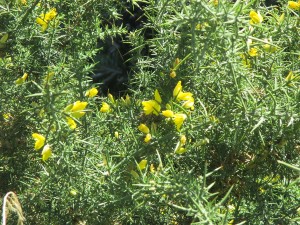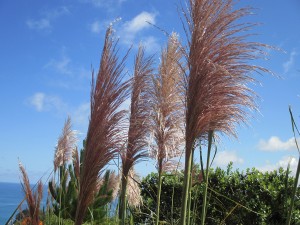Which Plant Or Weed?
Which Plant Or Weed?
Pest Plants (otherwise known as weeds!)
There is a saying that a weed is simply a plant in the wrong place. Most are garden escapees – cherished in the suburban garden for their colour and beauty, but death to the native ecosystem!
Piha Coastcare is committed to contributing to a weedfree local environment. Contact us for information, advice and support, equipment, herbicides.
Piha Coastcare prefers to avoid the use of chemicals where possible.
Important! If you don’t regularly follow up your weed elimination sessions for at least a couple of years, your efforts will probably have been in vain
Piha Nasties:
Pampas
Often confused with native Toetoe. Pampas is highly invasive in our environment, and has upright pinkish flowers in late summer. Native Toetoe has creamy drooping flowerheads before Christmas. Examination of the base of the leaves helps with identifying the different species. Invasive Pampas has dead foliage at the base which looks like wood shavings, and is a haven for rodents as well as a high fire risk.
Native Toetoe stems have a waxy base and no ‘wood shavings’.
Control
- Pull off, bag and dispose of new flower heads, even if you don’t have time to treat the plant.
- Dig out mature plants. Foliage can be left to compost
- Or, cut or slash foliage as close to the ground as possible. Can spray re-growth.
- Or, cut new flower stalks as close to the base as possible and spray glyphosate (Roundup) into the hollow stalk using a small plastic spray bottle. Mix 30/70 roundup/water. This will kill the whole plant.
Note: Spray is not effective during flowering time.
Agapanthus
Beautiful blue flowers in summer. The plants like inaccessible rocky hillsides, drains, banks, gardens and are highly invasive. Seeds are prolific and light, spreading widely via wind, water and gravity.
Control
- Remove, bag and dispose of flower heads, as a minimum action
- Dig out plants. Foliage can be left to decay, but remove seed heads
- Or, cut plants close to the ground and paint freshly cut surfaces with Vigilant gel
- Or, spray with Grazon and pulse. Likely to need repeat treatments
Gorse
Gorse is often used as a nursery plant to allow small natives to get to a good size before removing the gorse plants. The best gorse prevention is to establish shade which causes it to diminish or die.
Seeds remain viable in the ground for decades, so shade is the most effective long-term deterrent.
Control
- Hand pull seedlings and small plants
- Dig out larger plants
- Or, cut larger plants and immediately paste stumps with Vigilant gel or Roundup gel.
- Or, spray with glyphosate (Roundup)
Tradescantia (Wandering Jew)
A rampant forest floor competitor that prefers shade. Dense mats of vegetation smother all native ground covering plants and prevent other plants from establishing.
Control
- Rake or otherwise remove the bulk of the vegetation. Dispose of very carefully as any fragments will re-establish. Piha has a weed bin in the domain near the bowling Club. Alternatively vegetation can be buried.
- Cleared areas must be closely monitored, and any re-growth removed.
As a last resort, Grazon or Hydrocotyl Killer are suitable herbicides. Avoid using within 5 metres of waterways.
Useful Downloads
Weed Management – A Community Tool for Action
Useful Websites
Auckland Council / Pest Plant Search
An A-Z of plants and information on pest plant control techniques. Useful for identification of weeds as well as treatment.
Weedbusters
Useful for general information on weed control strategies and principles.
NatureWatch NZ
Instantly identify any New Zealand species of flora or fauna via your phone or computer. Send a photo or description and get an instant response.


